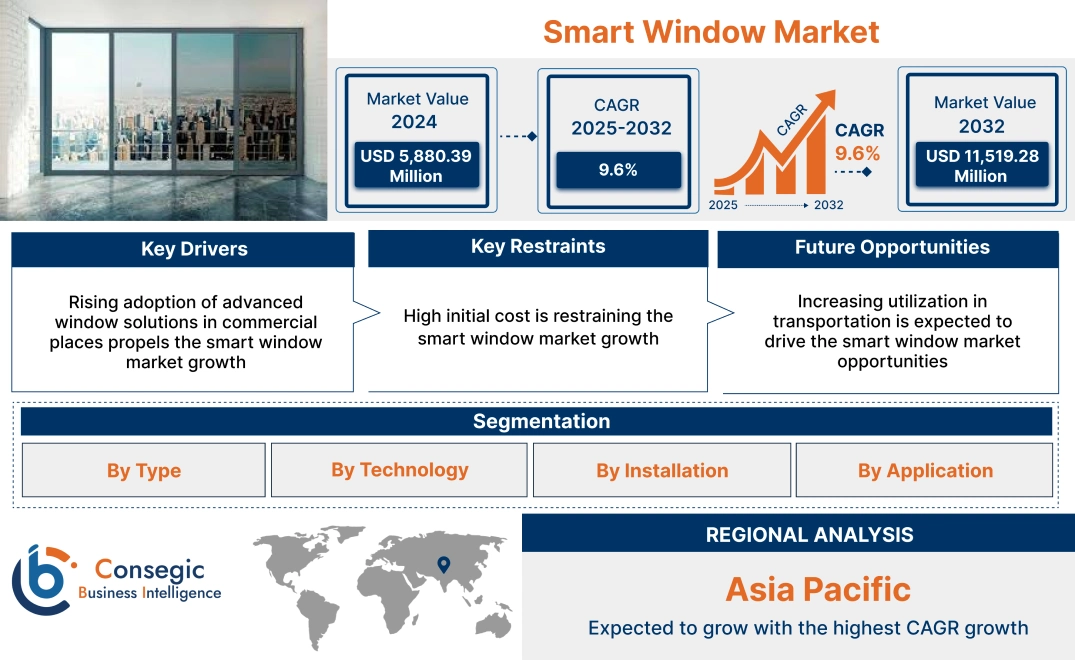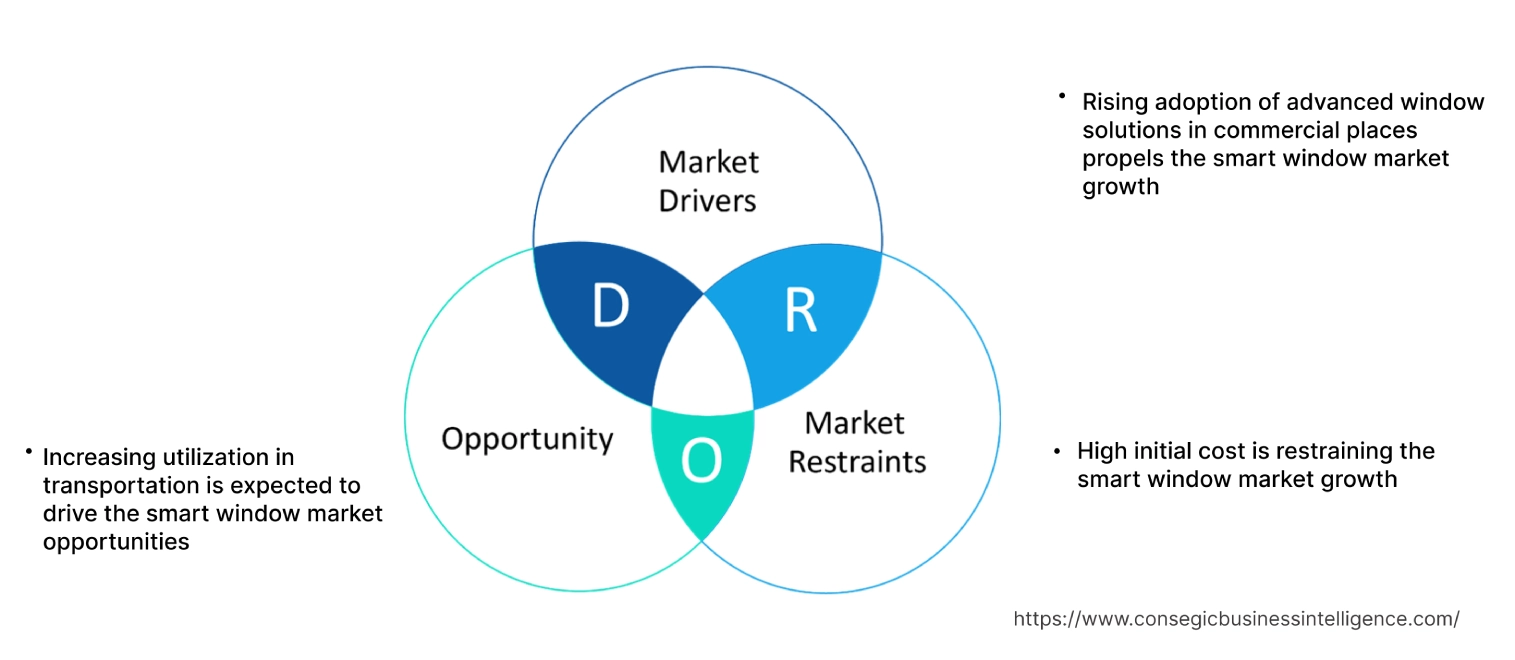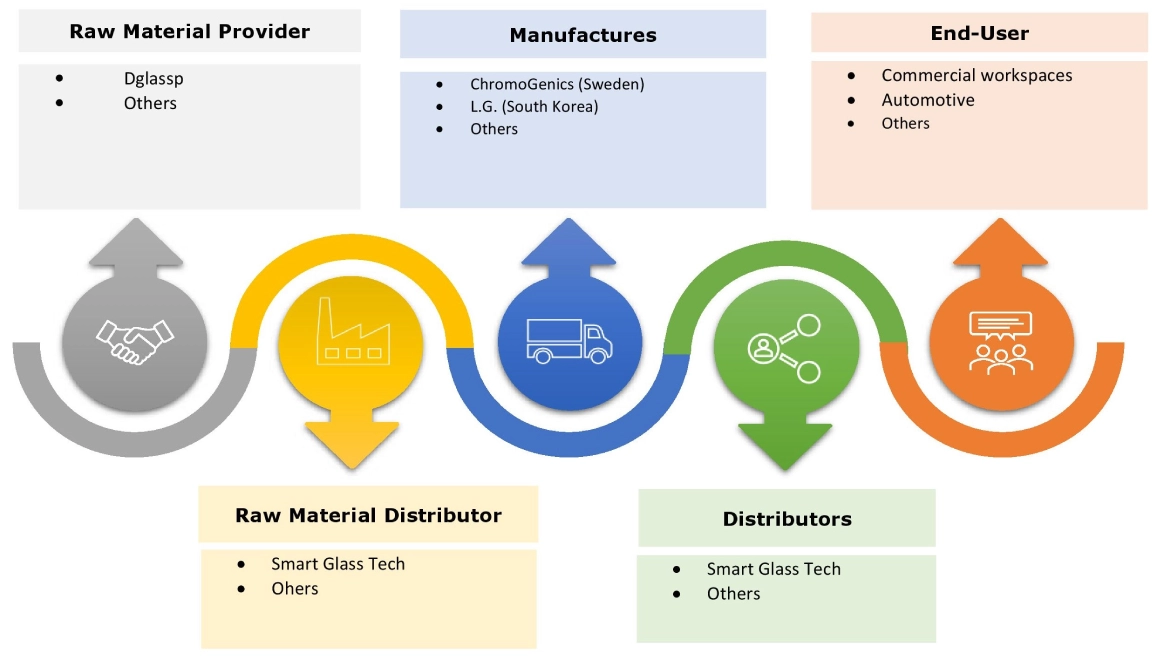- Summary
- Table Of Content
- Methodology
Smart Window Market Scope & Overview:
Smart window (SW) refers to switchable windows or switchable smart glass windows. Moreover, switchable glass is used for various applications, such as maintaining privacy, which traditional glass windows cannot provide. Further, SW works by integrating the PDLC (polymer dispersed liquid crystal) layer, suspended dispersed particles, and others into the glass surface of the product with no gap in the product and the layer.
Additionally, the layer is wired to the power source, which enables the product to switch between transparent and opaque states. SW offers various benefits such as UV protection, enhanced aesthetics, security, privacy, energy efficiency, and others.
Smart Window Market Size:
Smart Window Market size is estimated to reach over USD 11,519.28 Million by 2032 from a value of USD 5,880.39 Million in 2024 and is projected to grow by USD 6,297.90 Million in 2025, growing at a CAGR of 9.6% from 2025 to 2032.
Key Drivers:
Rising adoption of advanced window solutions in commercial places propels the smart window market growth
The integration of SW in commercial spaces, including retail establishments, workplaces, educational institutions, offices, and others is increasing due to enhanced energy efficiency, reduced utility costs, and improved indoor aesthetics.
It also promotes sustainability goals by using natural sunlight and heat insulation. Further, by integrating advanced window solutions in retail outlets, glare is controlled for a better customer experience. Additionally, it also helps to prevent the rotting of food by blocking sunlight and maintaining heat insulation properties.
- According to Statistics Netherlands, the total number of new construction projects of commercial buildings in the Netherlands including educational institutions, healthcare facilities, retail shops, offices, and others reached up to 1,042 units in 2022.
Thus, the rising investments in commercial workplaces are driving the smart window market size.
Key Restraints:
High initial cost is restraining the smart window market growth
The utilization of SW is usually associated with high cost. Moreover, SW equipment includes various components and advanced technologies, which significantly increases the overall installation cost. Additionally, the installation cost varies depending on the surface area being coated in residential, commercial, or industrial places and its specific usage.
Furthermore, the complexity of integrating advanced window systems with the coexisting window systems in commercial workplaces is quite difficult and presents a significant challenge. Hence, the high cost associated with SW installation is hindering the smart window market expansion.
Future Opportunities :
Increasing utilization in transportation is expected to drive the smart window market opportunities
The adoption of SW in the transportation sector involves integrating advanced glass technologies in vehicles, trains, and airplanes to regulate light and temperature. Moreover, instant solar reflection and shading remove road glare and ease interior temperatures while providing benefits to the manufacturers such as energy efficiency, reduced material costs, and optimized space.
Additionally, advanced glass technology is implemented in sunroofs, sun visors, passenger windows, side window displays, and others.
- For instance, Gauzy offers smart and advanced window solutions for cars in its product offerings. It offers several benefits including light control, anti-glare, cooling, and others.
Thus, as per the smart window market analysis, the rising adoption of advanced window solutions in automotive is driving the global smart window market opportunities.
Top Key Players and Market Share Insights:
The smart window market is highly competitive with major players providing services to the national and international markets. Key players are adopting several strategies in research and development (R&D), product innovation, and end-user launches to hold a strong position in the global smart window market. Key players in the smart window industry include -
- Gauzy (Israel)
- Smart Window Colorado (US)
- ChromoGenics (Sweden)
- G. (South Korea)
- View Inc. (U.S)
- Innovative Glass Corporation (US)
- Polytronix, Inc. (US)
- SageGlass (US)
- Gentex Corporation (US)
- Stellaris Corporation (US)
Smart Window Market Segmental Analysis :
By Type:
Based on type, the market is segmented into active switchable glass and passive smart glass.
Trends in the type:
- There is an increasing trend toward the adoption of active switchable glass due to its various benefits such as smart glazing, heat resistivity, and enhanced privacy.
- Rising utilization of passive smart glass due to its various benefits such as insulation and other physical properties.
Active switchable glass accounted for the largest revenue share of 73.23% of the total smart window market share in 2024
- Active switchable glass refers to a glass that switches between opaque and transparent states.
- Moreover, switchable glass technologies comprise suspended particle device (SPD) glass, polymer dispersed liquid crystal (PDLC) glass, and electrochromic (EC) glass.
- For instance, in September 2022, LG Display launched transparent OLED, which uses suspended particle device (SPD) smart glass technology to improve durability and strength.
- According to the analysis, the rising developments related to switchable glass are driving the smart window market size.
Passive smart glass is anticipated to register a significant CAGR during the forecast period.
- Passive smart glass is made of a polarizing lens, which is triggered for changing optical properties.
- Further, passive smart glass consists of photochromic glass which automatically tints in sunlight, and thermochromic glass changes with respect to temperature change.
- Additionally, smart glasses insulate and block light by changing the physical properties of glasses.
- For instance, Smart Window Colorado offers passive smart glasses in its product offerings. The smart glass offers benefits such as anti-heat and anti-glare.
- Thus, the rising advancements related to passive smart glasses are driving the smart window market trends.
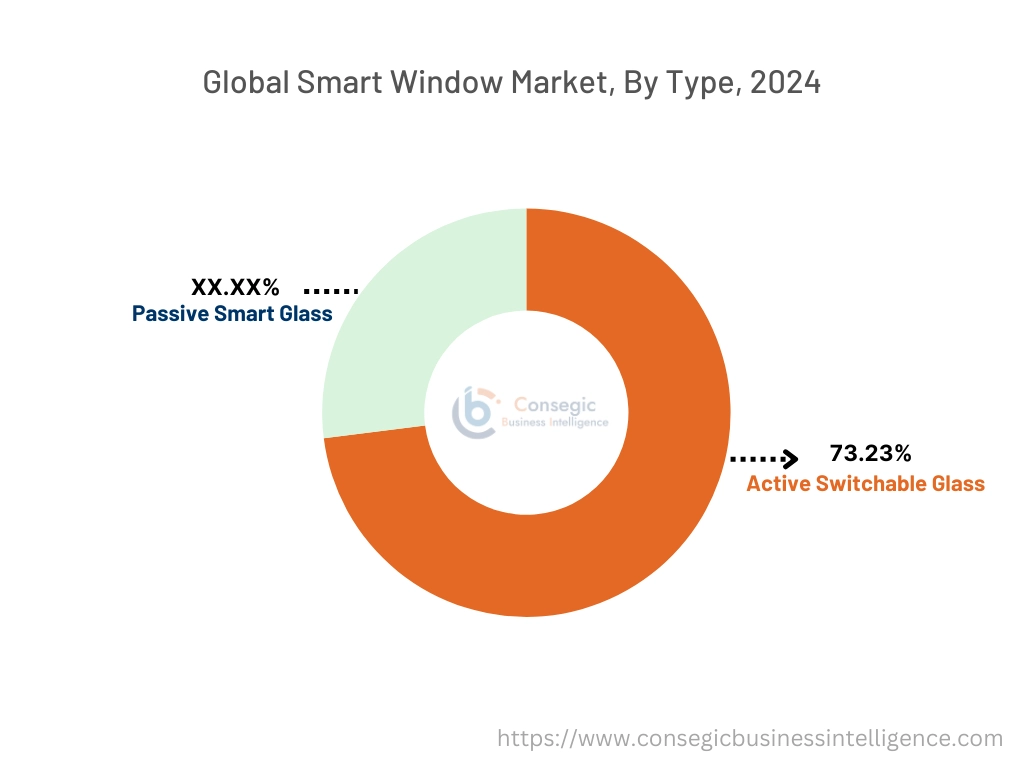
By Technology:
Based on the technology, the market is segmented into polymer dispersed liquid crystal, suspended particle, electrochromic, photochromic, and thermochromic.
Trends in the technology:
- There is an increasing adoption of thermochromic window solutions due to their ability to respond to heat intensity.
- Rising utilization of polymer dispersed liquid crystal due to their smart glazing transparency solutions.
The electrochromic segment accounted for the largest revenue in the total smart window market share in 2024.
- Electrochromic technology refers to the glasses that are triggered by an electrical signal to change states from opaque to transparent.
- Further, electrochromic technology offers benefits such as modern aesthetics and a clean look due to fewer shading devices.
- Additionally, electrochromic technology is used in rearview mirrors, sunroofs, automotive mirrors, sunglasses, and others.
- For instance, Gentex Corporation offers electrochromic dimmable glass in its product offerings. The electrochromic technology offers benefits such as high contrast for head-up displays or transparent windscreens.
- Thus, the rising utilization of electrochromic technology in automotive mirrors, sunroofs, and others is driving the market.
Suspended particle segment is anticipated to register the fastest CAGR during the forecast period.
- Suspended particle (SPD) glass is a switchable glass that turns from a transparent state to an opaque state and vice versa in response to electrical or thermal signals.
- Moreover, suspended particle helps in controlling light, privacy, and heat in different commercial and residential locations.
- For instance, in July 2022, Cadillac launched CELESTIQ with a smart glass roof feature, integrated with suspended particle device technology
- Thus, the rising advancements in suspended particle device technology are driving the market.
By Installation:
Based on the installation, the market is segmented into new installation and retrofit.
Trends in the installation:
- There is an increasing trend toward new installation of smart glasses in commercial places and industrial centers.
- The increasing utilization of retrofit solutions in the automotive industry for sunroofs and mirrors.
New installation accounted for the largest revenue share in 2024.
- New installation of advanced window solutions based on smart glass technology is growing due to rising demand from new retail establishments, workplaces, educational institutions, offices, and others.
- Moreover, the new installation includes different glasses such as polymer dispersed liquid crystal glass, suspended particle glass, electrochromic glasses, photochromic glasses, and thermochromic glasses.
- For instance, in 2023, Freshippo launched 12 grocery stores across 8 cities in existing networks in Mainland China including Shanghai, Beijing, and Guangzhou. This is further driving the integration of advanced window solutions in retail outlets to prevent the rotting of grocery items.
- According to the analysis, the rising development of commercial and industrial spaces is driving the smart window market trends.
The retrofit segment is anticipated to register the fastest CAGR during the forecast period.
- Retrofit installation refers to the installation of self-adhesive switchable smart film on existing spaces, which is applied on the glass to prevent heat and light.
- Further, retrofit installation offers various benefits such as affordability, versatility, UV protection, and others.
- Additionally, self-adhesive switchable smart film is an ideal solution for customers who are willing to undergo a mechanical change.
- For instance, Intelligent Glass offers to retrofit advanced window solutions solutions in its solution offerings. The retrofit smart window offers benefits including low cost, prevention of UV rays, and others.
- Therefore, the rising utilization of retrofit solutions is driving the market.
By Application:
Based on the application, the market is segmented into commercial, residential, transportation, and industrial.
Trends in the application:
- There is an increasing trend in new installation of advanced window solutions in residential places for window solutions.
- Rising utilization of retrofit solutions is trending in the transportation industry for sunroofs and mirrors.
The commercial segment accounted for the largest revenue share in 2024.
- There is an increasing utilization of smart glass solutions in new retail establishments, workplaces, educational institutions, offices, and others in the commercial sector.
- Moreover, benefits include privacy, low maintenance, heat prevention in indoor places, improved security, and others.
- For instance, WeWork India unveiled new office space in Bengaluru with a carpet area of 61,120+ square feet for multinational corporations. This is driving the utilization of advanced glass solutions for modern aesthetics, providing ample light, and others.
- According to the analysis, the rising development of commercial workplaces, establishments, and institutions is driving the smart window market.
The transportation segment is anticipated to register the fastest CAGR during the forecast period.
- The rising utilization of SW is transforming transportation across air, water, and land modes.
- Moreover, it offers benefits such as privacy control, glare control, and smart glass panels in buses, trains, aircraft, and others.
- According to the ATAG (Air Transport Action Group), in 2023, 35.3 million commercial flights and 96 million aircraft movements took place worldwide.
- According to the analysis, the rising utilization of advanced window solutions in the transportation sector for glare and heat control is driving the smart window market.
Smart Window Market Report Insights :
| Report Attributes | Report Details |
| Study Timeline | 2019-2032 |
| Market Size in 2032 | USD 11,519.28 Million |
| CAGR (2025-2032) | 9.6% |
| By Type |
|
| By Technology |
|
| By Installation |
|
| By Application |
|
| By Region |
|
| Key Players |
|
| North America | U.S. Canada Mexico |
| Europe | U.K. Germany France Spain Italy Russia Benelux Rest of Europe |
| APAC | China South Korea Japan India Australia ASEAN Rest of Asia-Pacific |
| Middle East and Africa | GCC Turkey South Africa Rest of MEA |
| LATAM | Brazil Argentina Chile Rest of LATAM |
| Report Coverage |
|
Regional Analysis:
The regions covered are North America, Europe, Asia Pacific, the Middle East and Africa, and Latin America.
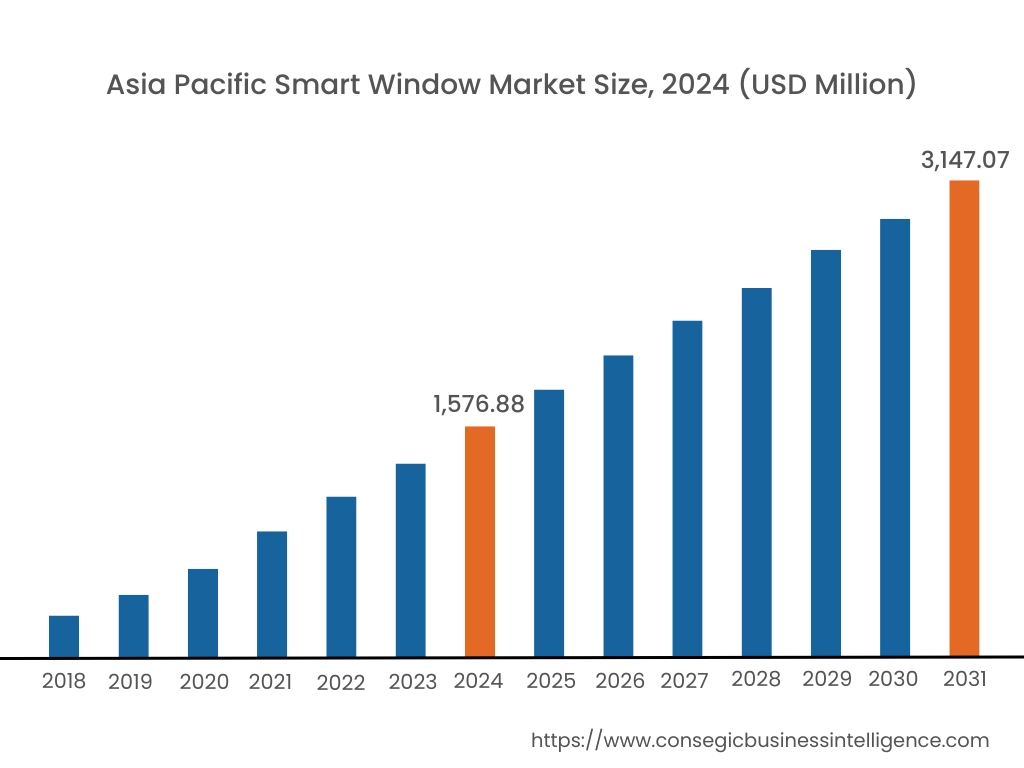
Asia Pacific region was valued at USD 1,576.88 Million in 2024. Moreover, it is projected to grow by USD 1,691.48 Million in 2025 and reach over USD 3,147.07 Million by 2032. Out of this, China accounted for the maximum revenue share of 32.8%. As per the smart window market analysis, there is an increasing adoption of advanced window solutions, particularly in countries such as China, India, and Japan, for preventing heat absorption in commercial places. The rapid development and growing investments in commercial spaces are accelerating the smart window market expansion.
- For instance, according to the BCA (Building and Construction Authority of Singapore), in Singapore the total construction demand including commercial and residential construction is expected to reach between USD 24 billion to USD 29 billion by the end of 2024. Thus, the above factors are projected to boost the market growth.
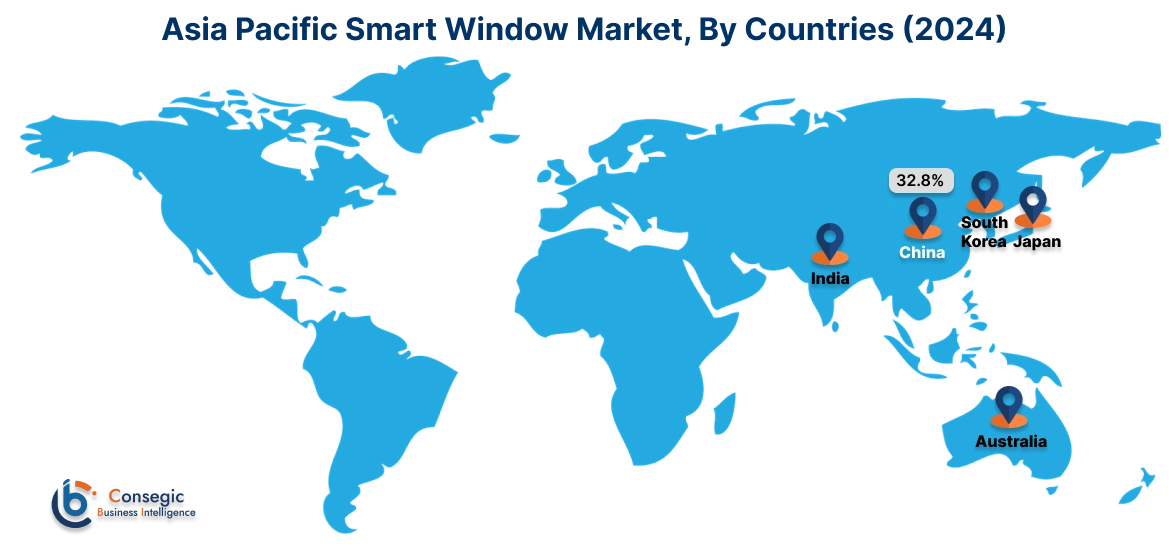
North America is estimated to reach over USD 4,103.17 Million by 2032 from a value of USD 2,102.50 Million in 2024 and is projected to grow by USD 2,251.07 Million in 2025. In North America, the growth of the smart window industry is driven by the rising demand for smart solutions for controlling temperature and UV rays in modern vehicles and during the manufacturing of various electronic products and others, to improve heat resistivity. Rising utilization of advanced window systems in cars is also contributing to growth in smart window market demand.
- For instance, in October 2024, Mativ, a US-based company collaborated with Miru Smart Technologies to develop electrochromic windows for the architectural and transportation sector.
The regional analysis depicts that the rising automotive manufacturing is driving the smart window market demand in Europe. Further, as per the market analysis, the primary factor driving the market growth in the Middle East and African region includes increasing investment in modern infrastructure and urbanization. The rising demand for modern commercial and residential places is accelerating the demand for effective heat and glare technology, which in turn is driving the market growth in the Latin America region.
Recent Industry Developments :
Research and Development:
- In August 2024, Professor Seung Hwan Ko's team from Seoul National University developed a multifunctional smart window, which is used to lower indoor temperature with less power usage.
Key Questions Answered in the Report
How big is the smart window market? +
The smart window market was valued at USD 5,880.39 Million in 2024 and is projected to grow to USD 11,519.28 Million by 2032.
Which is the fastest-growing region in the smart window market? +
Asia-Pacific is the region experiencing the most rapid growth in the smart window market.
What specific segmentation details are covered in the smart window report? +
The smart window report includes specific segmentation details for type, technology, installation, application, and region.
Who are the major players in the smart window market? +
The key participants in the Smart window market are Gauzy (Israel), Smart Window Colorado (US), Innovative Glass Corporation (US), Polytronix, Inc. (US), SageGlass (US), Gentex Corporation (US), Stellaris Corporation (US), ChromoGenics (Sweden), L.G. (South Korea), and View Inc. (U.S).
